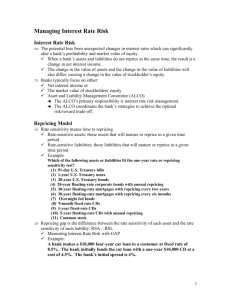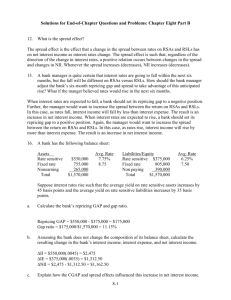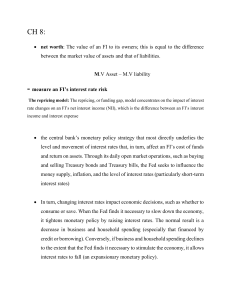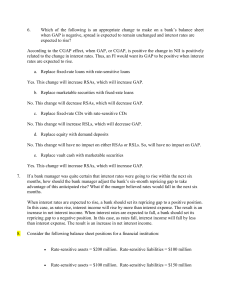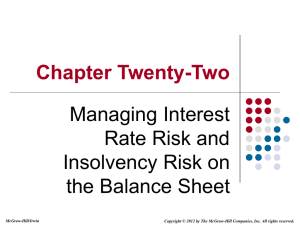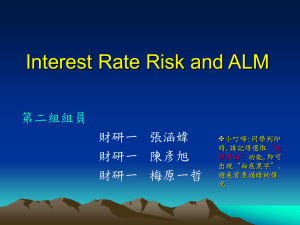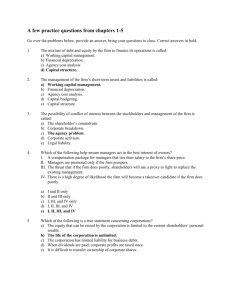Interest Rate Risk Solutions: Repricing Model
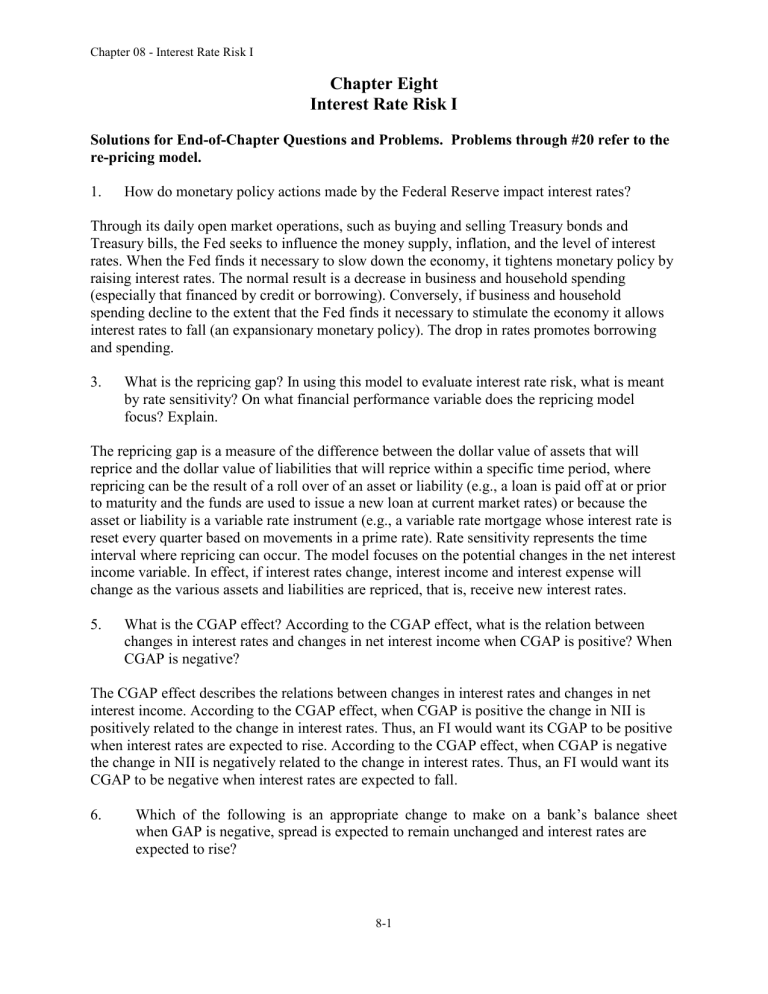
Chapter 08 - Interest Rate Risk I
Chapter Eight
Interest Rate Risk I
Solutions for End-of-Chapter Questions and Problems. Problems through #20 refer to the re-pricing model.
1. How do monetary policy actions made by the Federal Reserve impact interest rates?
Through its daily open market operations, such as buying and selling Treasury bonds and
Treasury bills, the Fed seeks to influence the money supply, inflation, and the level of interest rates. When the Fed finds it necessary to slow down the economy, it tightens monetary policy by raising interest rates. The normal result is a decrease in business and household spending
(especially that financed by credit or borrowing). Conversely, if business and household spending decline to the extent that the Fed finds it necessary to stimulate the economy it allows interest rates to fall (an expansionary monetary policy). The drop in rates promotes borrowing and spending.
3. What is the repricing gap? In using this model to evaluate interest rate risk, what is meant by rate sensitivity? On what financial performance variable does the repricing model focus? Explain.
The repricing gap is a measure of the difference between the dollar value of assets that will reprice and the dollar value of liabilities that will reprice within a specific time period, where repricing can be the result of a roll over of an asset or liability (e.g., a loan is paid off at or prior to maturity and the funds are used to issue a new loan at current market rates) or because the asset or liability is a variable rate instrument (e.g., a variable rate mortgage whose interest rate is reset every quarter based on movements in a prime rate). Rate sensitivity represents the time interval where repricing can occur. The model focuses on the potential changes in the net interest income variable. In effect, if interest rates change, interest income and interest expense will change as the various assets and liabilities are repriced, that is, receive new interest rates.
5. What is the CGAP effect? According to the CGAP effect, what is the relation between changes in interest rates and changes in net interest income when CGAP is positive? When
CGAP is negative?
The CGAP effect describes the relations between changes in interest rates and changes in net interest income. According to the CGAP effect, when CGAP is positive the change in NII is positively related to the change in interest rates. Thus, an FI would want its CGAP to be positive when interest rates are expected to rise. According to the CGAP effect, when CGAP is negative
6. the change in NII is negatively related to the change in interest rates. Thus, an FI would want its
CGAP to be negative when interest rates are expected to fall.
Which of the following is an appropriate change to make on a bank’s balance sheet when GAP is negative, spread is expected to remain unchanged and interest rates are expected to rise?
8-1
Chapter 08 - Interest Rate Risk I a.
According to the CGAP effect, when CGAP is positive the change in NII is positively related to the change in interest rates. Thus, an FI would want its CGAP to be positive when interest rates are expected to rise. replace fixed rate loans with rate sensitive loans
Yes. This change will increase RSAs, which will increase GAP. b. replace marketable securities with fixed rate loans
No. This change will decrease RSAs, which will decrease GAP. c. replace fixed rate CDs with rate sensitive CDs
No. This change will increase RSLs, which will decrease GAP. d. replace equity with demand deposits
No. This change will have no impact on either RSAs or RSLs. So, no impact on GAP either. e. replace vault cash with marketable securities
Yes. This change will increase RSAs, which will increase GAP.
7. If a bank manager was quite certain that interest rates were going to rise within the next six months, how should the bank manager adjust the bank’s six-month repricing gap to take advantage of this anticipated rise? What if the manger believed rates would fall in the next six months.
When interest rates are expected to rise, a bank should set its repricing gap to a positive position.
In this case, as rates rise, interest income will rise by more than interest expense. The result is an increase in net interest income. When interest rates are expected to fall, a bank should set its repricing gap to a negative position. In this case, as rates fall, interest income will fall by less than interest expense. The result is an increase in net interest income.
8. Consider the following possible balance sheet positions for a financial institution:
•
Rate-sensitive assets = $200 million. Rate-sensitive liabilities = $100 million
•
Rate-sensitive assets = $100 million. Rate-sensitive liabilities = $150 million
•
Rate-sensitive assets = $150 million. Rate-sensitive liabilities = $140 million
(note that each of the above is an independent case) a. Calculate the repricing gap and the impact on net interest income of a 1 percent increase in interest rates for each position.
8-2
Chapter 08 - Interest Rate Risk I
•
Rate-sensitive assets = $200 million. Rate-sensitive liabilities = $100 million.
Repricing gap = RSA - RSL = $200 - $100 million = +$100 million.
∆
NII = ($100 million)(.01) = +$1.0 million, or $1,000,000.
•
Rate-sensitive assets = $100 million. Rate-sensitive liabilities = $150 million.
Repricing gap = RSA - RSL = $100 - $150 million = -$50 million.
∆
NII = (-$50 million)(.01) = -$0.5 million, or -$500,000.
•
Rate-sensitive assets = $150 million. Rate-sensitive liabilities = $140 million.
Repricing gap = RSA - RSL = $150 - $140 million = +$10 million.
∆
NII = ($10 million)(.01) = +$0.1 million, or $100,000. b. Calculate the impact on net interest income on each of the above situations assuming a
1 percent decrease in interest rates.
• ∆
NII = ($100 million)(-.01) = -$1.0 million, or -$1,000,000.
• ∆
NII = (-$50 million)(-.01) = +$0.5 million, or $500,000.
• ∆
NII = ($10 million)(-.01) = -$0.1 million, or -$100,000. c. What conclusion can you draw about the repricing model from these results?
The FIs in parts (1) and (3) are exposed to interest rate declines (positive repricing gap), while the FI in part (2) is exposed to interest rate increases. The FI in part (3) has the lowest interest rate risk exposure since the absolute value of the repricing gap is the lowest, while the opposite is true for the FI in part (1).
10. What is the gap ratio? What is the value of this ratio to interest rate risk managers and regulators?
The gap ratio is the ratio of the cumulative gap position to the total assets of the FI. The cumulative gap position is the sum of the individual gaps over several time buckets. The value of this ratio is that it tells the direction of the interest rate exposure and the scale of that exposure relative to the size of the FI.
11. Which of the following assets or liabilities fit the one-year rate or repricing sensitivity test?
3-month U.S. Treasury bills
1-year U.S. Treasury notes
20-year U.S. Treasury bonds
20-year floating-rate corporate bonds with annual repricing
Yes
Yes
No
Yes
30-year floating-rate mortgages with repricing every two years
30-year floating-rate mortgages with repricing every six months
No
Yes
8-3
Chapter 08 - Interest Rate Risk I
Overnight fed funds
9-month fixed rate CDs
1-year fixed-rate CDs
5-year floating-rate CDs with annual repricing
Common stock
12. What is the spread effect?
Yes
Yes
Yes
Yes
No
The spread effect is the effect that a change in the spread between rates on RSAs and RSLs has on net interest income as interest rates change. The spread effect is such that, regardless of the direction of the change in interest rates, a positive relation exists between changes in the spread and changes in NII. Whenever the spread increases (decreases), NII increases (decreases).
15. Use the following information about a hypothetical government security dealer named M.P.
Jorgan. Market yields are in parenthesis, and amounts are in millions.
Assets
Cash
1-month T-bills (7.05%)
3-month T-bills (7.25%)
2-year T-notes (7.50%)
8-year T-notes (8.96%)
5-year munis (floating rate)
Liabilities and Equity
$10 Overnight repos
75 Subordinated debt
75 7-year fixed rate (8.55%)
50
100
(8.20% reset every 6 months) 25
Total assets $335
Equity
Total liabilities & equity
$170
150
15
$335 a. What is the repricing gap if the planning period is 30 days? 3 months? 2 years? Recall that cash is a non-interest-earning asset.
Repricing gap using a 30-day planning period = $75 - $170 = -$95 million.Repricing gap using a 3-month planning period = ($75 + $75) - $170 = -$20 million.
Reprising gap using a 2-year planning period = ($75 + $75 + $50 + $25) - $170 = +$55 million. b. What is the impact over the next 30 days on net interest income if interest rates increase
50 basis points? Decrease 75 basis points?
If interest rates increase 50 basis points, net interest income will decrease by $475,000.
∆
NII = CGAP(
∆
R) = -$95m.(.005) = -$0.475m.
If interest rates decrease by 75 basis points, net interest income will increase by $712,500.
∆
NII = CGAP(
∆
R) = -$95m.(-.0075) = $0.7125m.
16. A bank has the following balance sheet:
Assets Avg. Rate Liabilities/Equity Avg. Rate
Rate sensitive $550,000 7.75% Rate sensitive $375,000 6.25%
8-4
Chapter 08 - Interest Rate Risk I
Fixed rate 755,000 8.75
Nonearning 265,000
Total $1,570,000
Fixed rate 805,000 7.50
Nonpaying 390,000
Total $1,570,000
Suppose interest rates rise such that the average yield on rate-sensitive assets increases by
45 basis points and the average yield on rate-sensitive liabilities increases by 35 basis points. a. Calculate the bank’s repricing GAP and gap ratio.
Repricing GAP = $550,000 - $375,000 = $175,000
Gap ratio = $175,000/$1,570,000 = 11.15% b. Assuming the bank does not change the composition of its balance sheet, calculate the resulting change in the bank’s interest income, interest expense, and net interest income.
∆
II = $550,000(.0045) = $2,475
∆
IE = $375,000(.0035) = $1,312.50
∆
NII = $2,475 - $1,312.50 = $1,162.50 c. Explain how the CGAP and spread effects influenced the change in net interest income.
The CGAP affect worked to increase net interest income. That is, the CGAP was positive while interest rates increased. Thus, interest income increased by more than interest expense. The result is an increase in NII. The spread effect also worked to increase net interest income. The spread increased by 10 basis points. According to the spread affect, as spread increases, so does net interest income.
20. What are some of the weakness of the repricing model? How have large banks solved the problem of choosing the optimal time period for repricing? What is runoff cash flow, and how does this amount affect the repricing model’s analysis?
The repricing model has four general weaknesses:
(1) It ignores market value effects.
(2) It does not take into account the fact that the dollar value of rate-sensitive assets and liabilities within a bucket are not similar. Thus, if assets, on average, are repriced earlier in the bucket than liabilities, and if interest rates fall, FIs are subject to reinvestment risks.
(3) It ignores the problem of runoffs. That is, that some assets are prepaid and some liabilities are withdrawn before the maturity date.
(4) It ignores income generated from off-balance-sheet activities.
8-5
Chapter 08 - Interest Rate Risk I
Large banks are able to reprice securities every day using their own internal models so reinvestment and repricing risks can be estimated for each day of the year.
Runoff cash flow reflects the assets that are repaid before maturity and the liabilities that are withdrawn unexpectedly. To the extent that either of these amounts is significantly greater than expected, the estimated interest rate sensitivity of the FI will be in error.
Problems 21, 22 & 32 refer to the Maturity Model.
21. What is a maturity gap? How can the maturity model be used to immunize an FI’s portfolio? What is the critical requirement that allows maturity matching to have some success in immunizing the balance sheet of an FI?
Maturity gap is the difference between the average maturity of assets and liabilities. If the maturity gap is zero, it is possible to immunize the portfolio so that changes in interest rates will result in equal but offsetting changes in the value of assets and liabilities. Thus, if interest rates increase (decrease), the fall (rise) in the value of the assets will be offset by an identical fall (rise) in the value of the liabilities. The critical assumption is that the timing of the cash flows on the assets and liabilities must be the same.
22. Nearby Bank has the following balance sheet (in millions):
Assets
Cash
5-year Treasury notes
30-year mortgages
Total assets
$60
Liabilities and Equity
Demand deposits $140
60 1-year certificates of deposit 160
200 Equity 20
$320 Total liabilities and equity $320
What is the maturity gap for Nearby Bank? Is Nearby Bank more exposed to an increase or decrease in interest rates? Explain why?
M
A
= [0*60 + 5*60 + 30*200]/320 = 19.6875 years, and M
L
= [0*140 + 1*160]/300 = 0.5333.
Therefore, the maturity gap = MGAP = 19.6875 – 0.5333 = 19.1542 years. Nearby Bank is exposed to an increase in interest rates. If rates rise, the value of assets will decrease much more than the value of liabilities.
32. What are the weaknesses of the maturity model?
First, the maturity model does not consider the degree of leverage on the balance sheet. For example, if assets are not financed entirely with deposits, a change in interest rates may cause the assets to change in value by a different amount than the liabilities. Second, the maturity model does not take into account the timing of the cash flows of either the assets or the liabilities, and thus reinvestment and/or refinancing risk may become important factors in profitability and valuation as interest rates change.
8-6
